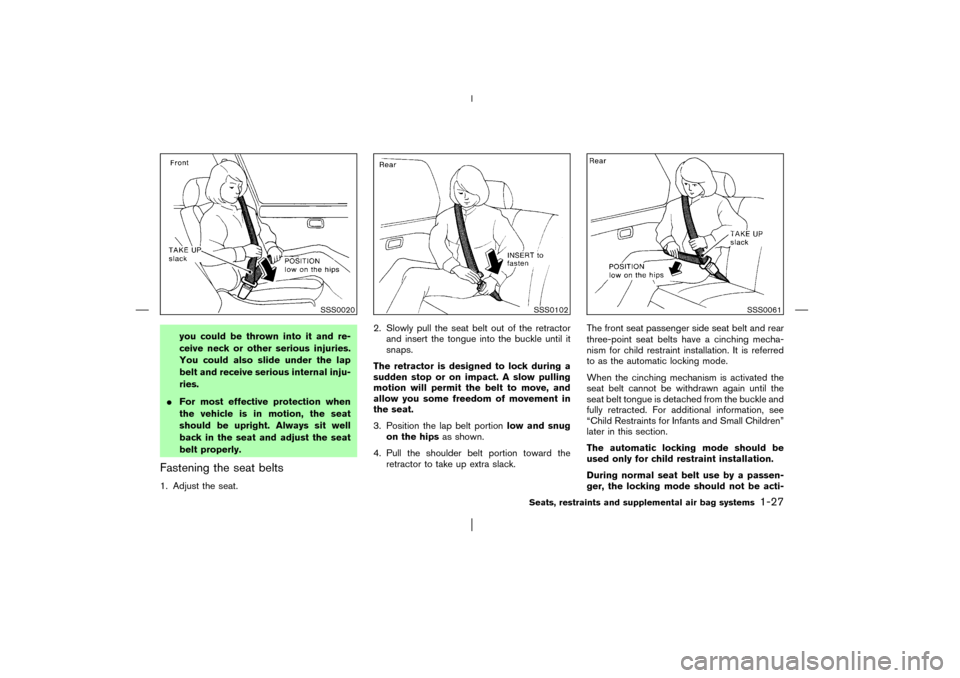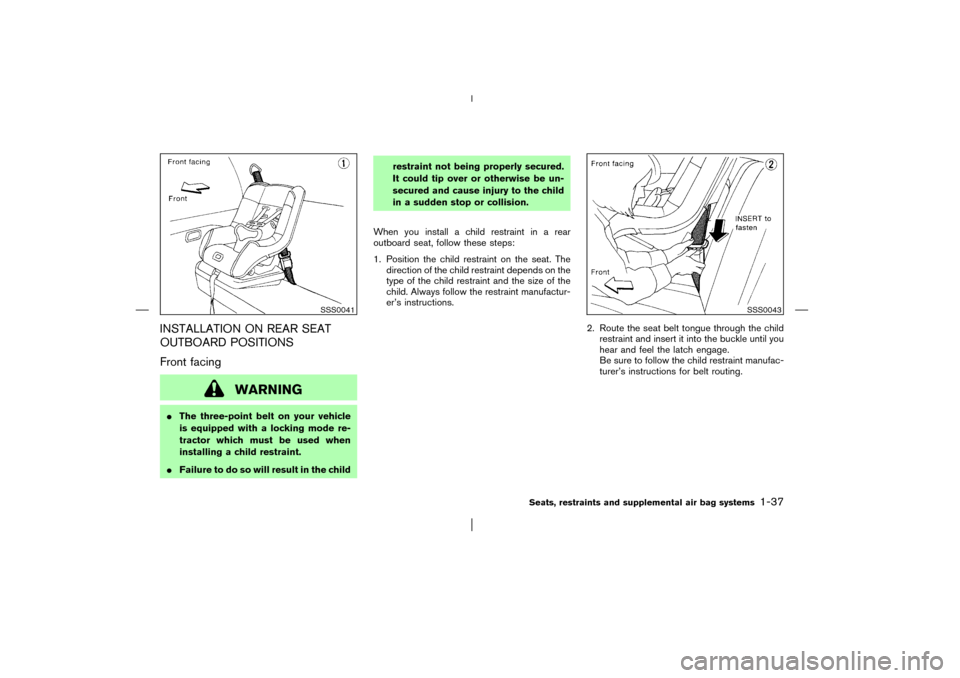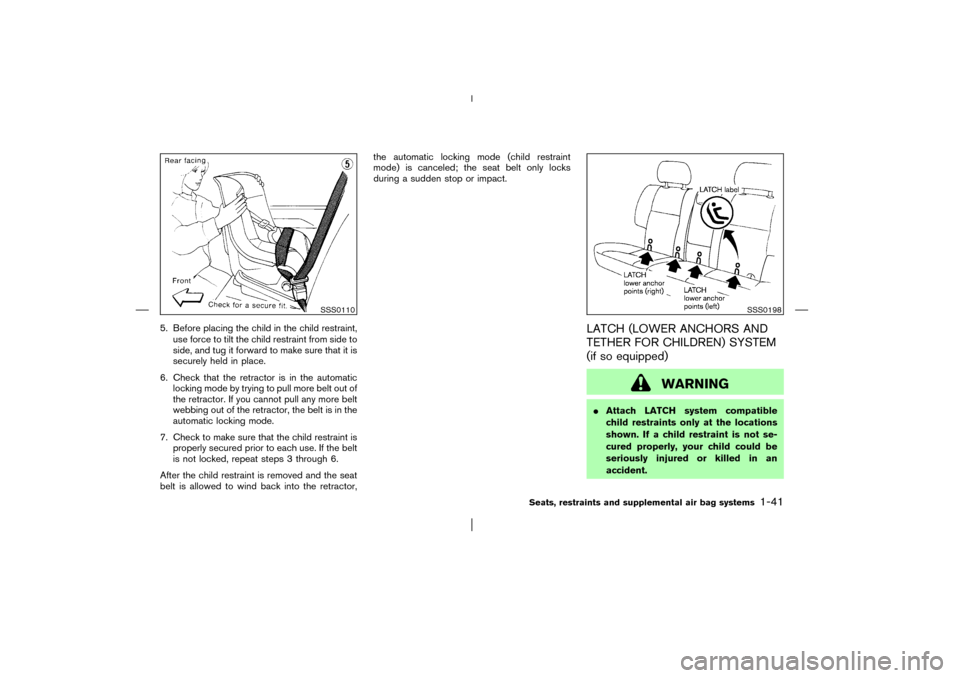Page 34 of 299

you could be thrown into it and re-
ceive neck or other serious injuries.
You could also slide under the lap
belt and receive serious internal inju-
ries.
�For most effective protection when
the vehicle is in motion, the seat
should be upright. Always sit well
back in the seat and adjust the seat
belt properly.
Fastening the seat belts1. Adjust the seat.2. Slowly pull the seat belt out of the retractor
and insert the tongue into the buckle until it
snaps.
The retractor is designed to lock during a
sudden stop or on impact. A slow pulling
motion will permit the belt to move, and
allow you some freedom of movement in
the seat.
3. Position the lap belt portionlow and snug
on the hipsas shown.
4. Pull the shoulder belt portion toward the
retractor to take up extra slack.The front seat passenger side seat belt and rear
three-point seat belts have a cinching mecha-
nism for child restraint installation. It is referred
to as the automatic locking mode.
When the cinching mechanism is activated the
seat belt cannot be withdrawn again until the
seat belt tongue is detached from the buckle and
fully retracted. For additional information, see
“Child Restraints for Infants and Small Children”
later in this section.
The automatic locking mode should be
used only for child restraint installation.
During normal seat belt use by a passen-
ger, the locking mode should not be acti-
SSS0020
SSS0102
SSS0061
Seats, restraints and supplemental air bag systems
1-27
�
03.1.28/R50-D/V5
�
Page 44 of 299

INSTALLATION ON REAR SEAT
OUTBOARD POSITIONS
Front facing
WARNING
�The three-point belt on your vehicle
is equipped with a locking mode re-
tractor which must be used when
installing a child restraint.
�Failure to do so will result in the childrestraint not being properly secured.
It could tip over or otherwise be un-
secured and cause injury to the child
in a sudden stop or collision.
When you install a child restraint in a rear
outboard seat, follow these steps:
1. Position the child restraint on the seat. The
direction of the child restraint depends on the
type of the child restraint and the size of the
child. Always follow the restraint manufactur-
er’s instructions.
2. Route the seat belt tongue through the child
restraint and insert it into the buckle until you
hear and feel the latch engage.
Be sure to follow the child restraint manufac-
turer’s instructions for belt routing.
SSS0041
SSS0043
Seats, restraints and supplemental air bag systems
1-37
�
03.1.28/R50-D/V5
�
Page 45 of 299

3. Pull on the shoulder belt until all of the belt is
fully extended. At this time, the belt retractor
is in the automatic locking mode (child re-
straint mode). It reverts back to emergency
locking mode when the buckle is unlatched
and the belt is allowed to fully retract.4. Allow the belt to retract. Pull up on the belt to
remove any slack in the belt.5. Before placing the child in the child restraint,
use force to tilt the child restraint from side to
side, and tug it forward to make sure that it is
securely held in place.
6. Check that the retractor is in the automatic
locking mode by trying to pull more belt out of
the retractor. If you cannot pull any more belt
webbing out of the retractor, the belt is in the
automatic locking mode.
7. Check to make sure that the child restraint is
properly secured prior to each use. If the belt
is not locked, repeat steps 3 through 6.
After the child restraint is removed and the seat
belt is allowed to wind back into the retractor,
SSS0107
SSS0062
SSS0108
1-38
Seats, restraints and supplemental air bag systems
�
03.1.28/R50-D/V5
�
Page 46 of 299
the automatic locking mode (child restraint
mode) is canceled; the seat belt only locks
during a sudden stop or impact.
Rear facing
WARNING
�The three-point belt on your vehicle
is equipped with a locking mode re-
tractor which must be used when
installing a child restraint.
�Failure to do so will result in the child
restraint not being properly secured.
It could tip over or otherwise be un-
secured and cause injury to the childin a sudden stop or collision.
When you install a child restraint in a rear
outboard seat, follow these steps:
1. Position the child restraint on the seat. The
direction of the child restraint depends on the
type of the child restraint and the size of the
child. Always follow the restraint manufactur-
er’s instructions.
SSS0044Seats, restraints and supplemental air bag systems
1-39
�
03.1.28/R50-D/V5
�
Page 47 of 299
2. Route the seat belt tongue through the child
restraint and insert it into the buckle until you
hear and feel the latch engage. Be sure to
follow the child restraint manufacturer’s in-
structions for belt routing.3. Pull on the shoulder belt until all of the belt is
fully extended. At this time, the belt retractor
is in the automatic locking mode (child re-
straint mode). It reverts back to emergency
locking mode when the belt is fully retracted.4. Allow the belt to retract. Pull up on the belt to
remove any slack in the belt.
SSS0046
SSS0045A
SSS0109
1-40
Seats, restraints and supplemental air bag systems
�
03.1.28/R50-D/V5
�
Page 48 of 299

5. Before placing the child in the child restraint,
use force to tilt the child restraint from side to
side, and tug it forward to make sure that it is
securely held in place.
6. Check that the retractor is in the automatic
locking mode by trying to pull more belt out of
the retractor. If you cannot pull any more belt
webbing out of the retractor, the belt is in the
automatic locking mode.
7. Check to make sure that the child restraint is
properly secured prior to each use. If the belt
is not locked, repeat steps 3 through 6.
After the child restraint is removed and the seat
belt is allowed to wind back into the retractor,the automatic locking mode (child restraint
mode) is canceled; the seat belt only locks
during a sudden stop or impact.
LATCH (LOWER ANCHORS AND
TETHER FOR CHILDREN) SYSTEM
(if so equipped)
WARNING
�Attach LATCH system compatible
child restraints only at the locations
shown. If a child restraint is not se-
cured properly, your child could be
seriously injured or killed in an
accident.
SSS0110
SSS0198
Seats, restraints and supplemental air bag systems
1-41
�
03.1.28/R50-D/V5
�
Page 52 of 299

INSTALLATION ON FRONT
PASSENGER SEAT
WARNING
�Never install a rear facing child re-
straint in the front passenger seat.
Supplemental front air bags inflate
with great force. A rear facing child
restraint could be struck by the front
air bag in a crash and could seriously
injure or kill your child.�NISSAN recommends that child re-
straints be installed in the rear seat.
However, if you must install a front
facing child restraint in the front pas-
senger seat, move the passenger
seat to the rearmost position.
�A child restraint with a top tether
strap should not be used in the front
passenger seat.
�The three-point belt in your vehicle is
equipped with a locking mode retrac-tor which must be used when install-
ing a child restraint.
�Failure to use the retractor’s locking
mode may result in the child restraint
not being properly secured. The child
restraint could tip over or otherwise
be unsecured and cause injury to the
child in a sudden stop or collision.
SSS0129Seats, restraints and supplemental air bag systems
1-45
�
03.1.28/R50-D/V5
�
Page 53 of 299
Front facingIf you must install a child restraint in the front
seat, follow these steps:
1. Position the child restraint on the front pas-
senger seat.It should be placed in a front
facing direction only.Move the seat to the
rear most position. Always follow the child
restraint manufacturer’s instructions.Child
restraints for infants must be used in
the rear facing direction and therefore
must not be used in the front seat.2. Route the seat belt tongue through the child
restraint and insert it into the buckle until you
hear and feel the latch engage.
Be sure to follow the child restraint manufac-
turer’s instructions for belt routing.3. Pull on the shoulder belt until all of the belt is
fully extended. At this time, the belt retractor
is in the automatic locking mode (child re-
straint mode). It reverts back to emergency
locking mode when the belt is fully retracted.
SSS0135
SSS0055
SSS0113
1-46
Seats, restraints and supplemental air bag systems
�
03.1.28/R50-D/V5
�